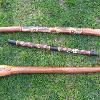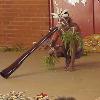

Rotated and resized. Tags: Didgeridoo View |
Foto1 Tags: Didgeridoo View |
1 2 3 4 5 6 7 8 9 et z�ro sont appel�s chiffres arabes Qui les a invent�s Le didgeridoo est un cuivre D o� vient le Marcel www culture generale fr Popularity 3 Tags: Didgeridoo View |
|||||||||
The didgeridoo (also known as a didjeridu or didge) is a wind instrument (musical instrument) developed by Indigenous Australians of northern Australia at least 1,500 years ago and is still in widespread usage today both in Australia and around the world. It is sometimes described as a natural wooden trumpet or "drone (drone (music)) pipe". Musicologists classify it as an aerophone. The instrument is traditionally made from Eucalyptus trees which have had their interiors hollowed out by termites or died of other causes.
There are no reliable sources stating the didgeridoos exact age. Archaeological studies of rock art in Northern Australia suggest that the Aboriginal people of the Kakadu region of the Northern Territory have been using the didgeridoo for at least 1,500 years, based on the dating of paintings on cave walls and shelters from this period. A clear rock painting in Ginga Wardelirrhmeng, on the northern edge of the Arnhem Land plateau, from the freshwater period shows a didgeridoo player and two songmen participating in an Ubarr Ceremony.
A modern didgeridoo is usually cylindrical or conical (Cone (geometry)), and can measure anywhere from convert1to3mft0abbr=on long. Most are around convert1.2mft0abbr=on long. The length is directly related to the 1/2 sound wavelength of the keynote. Generally, the longer the instrument, the lower the pitch or key of the instrument.
Image Capt: Top: Traditionally crafted & decorated,Middle: Bamboo souvenir didgeridoo,Bottom: Traditionally crafted & undecorated
Background: brass
Classification: *Wind (Wind instrument) *Aerophone
Hornbostel Sachs Desc: Aerophone sounded by lip movement
Range: Written range:center (File:Range trumpet.png)
Related: Trumpet, Flugelhorn, Cornet, Bugle (Bugle (instrument)),,Natural trumpet, Post horn, Roman tuba, Bucina (Cornu (horn)), Shofar, Conch, Lur, Baritone horn, Bronze Age Irish Horn



